LAB REPORT
Science and Technology Making Headlines
April 29, 2022
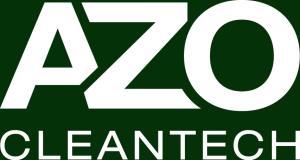
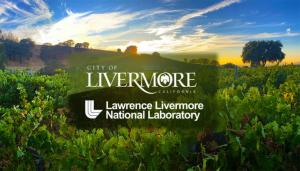
LLNL signed a memorandum of understanding with the City of Livermore to collaborate on advancing climate action in Livermore and build community-wide resilience to climate change impacts.
Going net zero in a city near you
Lawrence Livermore signed a memorandum of understanding (MOU) with the City of Livermore to collaborate on advancing climate action in Livermore and build community-wide resilience to climate change impacts.
The city's Climate Action Plan (CAP), anticipated to be adopted by the Livermore City Council this summer, will create a roadmap to achieve carbon neutrality (also known as net zero emissions) by 2045. The CAP also will include adaptation and resiliency strategies to prepare Livermore for a changing climate.
The city is developing strategies to be consistent with state climate mitigation targets (Senate Bill 32 and Executive Order B-55-18) and new legislation that requires cities to plan for the impacts of climate change (Senate Bill 379). Executive order B-55-18 mandates that the state achieve carbon neutrality by 2045 and maintain net negative emissions thereafter. Achieving this goal would complete a chain of other ambitious statewide targets for reducing greenhouse gas emissions.

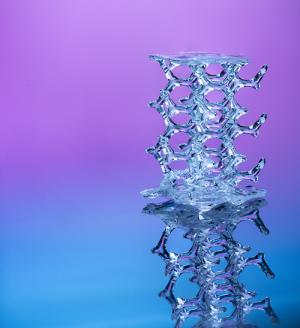
Researchers at LLNL and UC Berkeley demonstrated the ability to 3D-print microscopic objects in silica glass through volumetric additive manufacturing (VAM), part of an effort to produce delicate, layer-less optics that can be built in seconds or minutes. Image by Adam Lau/Berkeley Engineering.
It’s glasstastic
Among the latest efforts using a new laser-based VAM approach, researchers at Lawrence Livermore National Laboratory and the University of California, Berkeley have demonstrated the ability to 3D print microscopic objects in silica glass, part of an effort to produce delicate, layer-less optics that can be built in seconds or minutes.
Nicknamed “the replicator,” after the fictional device in Star Trek that can instantly fabricate nearly any object, the Computed Axial Lithography (CAL) technology developed by LLNL and UC Berkeley is inspired by computed tomography (CT) imaging methods. CAL works by computing projections from many angles through a digital model of a target object, optimizing these projections computationally, and then delivering them into a rotating volume of photosensitive resin using a digital light projector. Over time, the projected light patterns reconstruct, or build up, a 3D light dose distribution in the material, curing the object at points exceeding a light threshold while the vat of resin spins. In an ideal volumetric 3D printing setup, the fully formed object materializes in mere seconds — far faster than traditional layer-by-layer 3D printing techniques — and then the vat is drained to retrieve the part.
Combining a new microscale VAM technique called micro-CAL, which uses a laser instead of an LED source, with a nano-composite glass resin developed by the German company, Glassomer, and the University of Freiburg, UC Berkeley researchers reported the production of sturdy, complex microstructure glass objects with a surface roughness of just six nanometers with features down to a minimum of 50 microns.
Real-world applications could include micro-optics in high-quality cameras, consumer electronics, biomedical imaging, chemical sensors, virtual reality headsets, advanced microscopes, and microfluidics with challenging 3D geometries such as ‘lab on a chip’ applications, where microscopic channels are needed for medical diagnostics, fundamental scientific studies, nano-material manufacturing and drug screening.

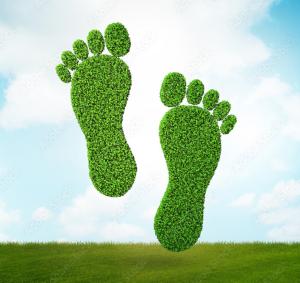
Caution is key when it comes to buying carbon offsets to undo environmental damage due to your carbon footprint.
Can offsets reduce my carbon footprint?
Companies that sell carbon offsets say they can undo environmental damage. Experts say some are better at it than others.
In response to increased awareness and concern over the warming planet, a growing number of airlines are offering customers the chance to purchase carbon offsets that, in theory at least, erase the CO2 emissions generated by their trips. But can paying a small premium really undo the environmental harm of your flight?
Many offsets are paying “entities that were already committed to storing the carbon.”
“Some of it is outright fraudulent, and a lot of times it is not additional, which is to say, it doesn’t cause something to happen that wouldn’t have happened in the absence of your money,” said Roger Aines, energy program chief scientist at Lawrence Livermore National Laboratory.
“The biggest challenge for consumers today is that there is no good clearinghouse that says this is a good offset and that others are not,” Aines said. “Second, most of these offsets operate well below the real price of actually removing that CO2 from the air. Some of them are just a few dollars per ton.” Aines said that $100 per ton is a more realistic figure.

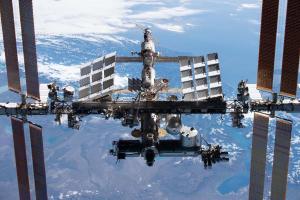
The International Space Station is pictured from the SpaceX Crew Dragon Endeavour during a fly-around of the orbiting lab that took place following its undocking from the Harmony module’s space-facing port on Nov. 8, 2021. Photo credit: NASA.
Cartilage in space
Scientists and engineers are exploring how volumetric additive manufacturing (VAM) 3D printing technology can produce artificial cartilage tissue in space.
Project collaborators — Lawrence Livermore National Laboratory (LLNL) and Kentucky-based space life sciences company Space Tango — are using VAM 3D printing techniques for bioprinting cartilage in microgravity on the International Space Station (ISS).
Microgravity environments allow objects to appear to be weightless and enable scientists to better understand physical properties and processes, which ultimately improve design and modeling. Without gravity, shapes are more perfect.
LLNL principal investigator Maxim Shusteff said that tissue engineering with VAM could be one area where spaceborne production in microgravity may significantly benefit the outcome. “Cartilage tissue was chosen as a good balance of market need, impact to patients, technical feasibility and our available expertise,” he said.

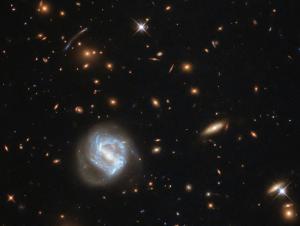
At first glance, this image is dominated by the vibrant glow of the swirling spiral to the lower left of the frame. However, this galaxy is far from the most interesting spectacle here — behind it sits a galaxy cluster. Image courtesy of NASA.
A galactic connection
Galaxies rarely live alone. Instead, dozens to thousands are drawn together by gravity, forming vast clusters that are the largest objects in the universe.
New research may point the way toward solving a decades-long mystery.
Scientists have long known that the hydrogen gas in galaxy clusters is searingly hot — about 10 million degrees Kelvin, or roughly the same temperature as the center of the sun — which is so hot that hydrogen atoms cannot exist. Instead the gas is a plasma consisting of protons and electrons. But a puzzle persists: There is no straightforward explanation for why or how the gas stays so hot. According to the normal rules of physics, it should have cooled within the age of the universe. But it hasn't.
The challenge for anyone trying to solve this puzzle is that you can't exactly create these kinds of powerfully hot and magnetic conditions in your backyard. However, there is now one place on Earth where you can: the most energetic laser facility in the world. The National Ignition Facility (NIF) at Lawrence Livermore National Laboratory can create such extreme conditions — though only for a tiny fraction of a second in a volume the size of a dime.





